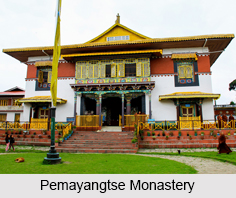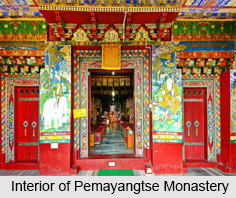 Pemayangtse Monastery is a Buddhist monastery in Pemayangtse town of Sikkim. It is the second oldest monastery of Sikkim. The monastery draws its name from "Padma yang tse" which literally means "sublime perfect lotus". The monastery follows the Nyingma Order of Tibet Buddhism and controls all other monasteries of that Order in Sikkim.
Pemayangtse Monastery is a Buddhist monastery in Pemayangtse town of Sikkim. It is the second oldest monastery of Sikkim. The monastery draws its name from "Padma yang tse" which literally means "sublime perfect lotus". The monastery follows the Nyingma Order of Tibet Buddhism and controls all other monasteries of that Order in Sikkim.
Monks of Pemayangtse Monastery
The monks of this monastery are normally chosen from the Bhutias of Sikkim. The monks of Pemayangtse Monastery are entitled to the title “Ta-Tshangâ€. The head lama of this monastery had the unique privilege of anointing the Chogyals of the erstwhile monarchy of Sikkim with holy water.
History of Pemayangtse Monastery
Pemayangtse Monastery was planned, designed and founded by Lama Lhatsun Chempo in 1705. It is one of the oldest monasteries of Sikkim and was first built as a small temple in the late 17th century. During the reign of the third Chogyal Chakdor Namgyal, Jigme Pawo, the monastery was enlarged.
Location of Pemayangtse Monastery
Pemayangtse Monastery is located at an elevation of 2085 m on a hill top in the west district of Sikkim. It is situated at the beginning of the popular Dzongri trek route; Yuksom-Dzongri-Goecha La. The monastery is located near Pelling and it is about 140 kilometres west of Gangtok. The view of Mount Kanchendzonga is said to be a commanding and impressive view from this monastery.
 Architecture of Pemayangtse Monastery
Architecture of Pemayangtse Monastery
The main gompa of the Pemayangtse Monastery is simple but has extremely attractive structure surrounded by pretty outhouses. The outhouses are adorned with beautiful woodwork on the beams, lattice, windows and doors. Built as a three storied structure, the monastery depicts paintings on its walls and statues of saints and Rinpoches. The monastery was damaged by earthquakes in 1913 and 1960 but has been rebuilt. The monastery belongs to the Nyingma order and houses statues of Guru Padmasambhava and his two consorts.
The main prayer hall has colourfully painted doors and windows that depict Tibetan designs. The first floor of the monastery has a notable collection of ancient Buddhist antique idols, scriptures as well as sculptures and decorated paintings portraying the "Sangthokpalri". It is the heavenly residence of the Guru Rimpoche rising above the realms of hell. The main statue of Guru Padmasambhava seen here is in his wrathful form as “Dorje Bhurpa Vjarakila†with multiple heads and arms. This structure was built by Dungzin Rimpoche over a period of 5 years.
The details of the intricate woodwork present demons, animals, birds, Buddha, bodhisattvas, Chortens and flying dragons. The monastery, which overlooks the Rabdentse ruins, has well manicured gardens within its compound where the residential accommodation for the monks is also located.
Festivals at Pemayangtse Monastery
The Pemayangtse Monastery celebrates the Chaam Festival every year, on the 28th and 29th day of the 12th lunar month of the Tibetan Calendar. It is a dance festival which is performed by the lamas of this monastery. The lamas dress up as "Mahakala" and "Guru Drag-dmar" in colourful costumes for the dance performance. Pilgrims from all parts of Sikkim flock here to witness this festival. This festive occasion marks the conclusion of the Losar (Tibetan New Year).
Visiting Information of Pemayangtse Monastery
Pemayangtse Monastery is located near Pelling which is about 2 kilometres and 110 kilometres from the capital city, Gangtok. Plenty of taxi services can be available from these places. The nearest airport is the Bagdogra airport (124 km) and the nearest railway station is at New Jalpaiguri (134 km).



















